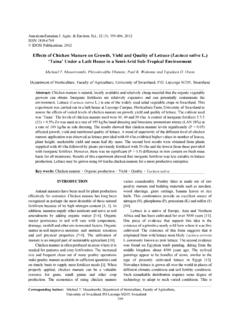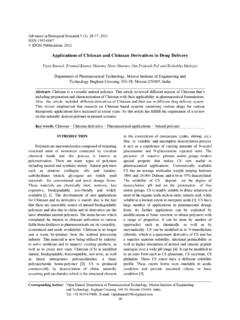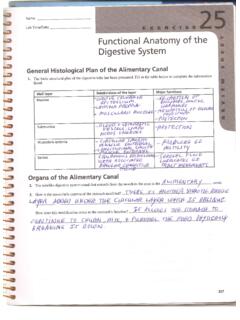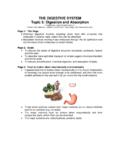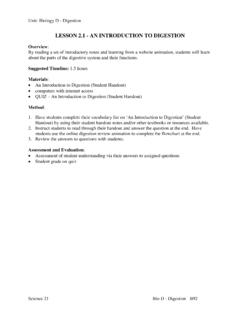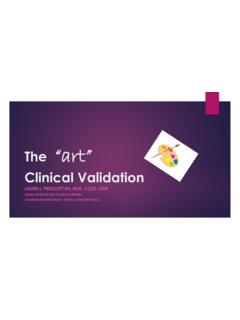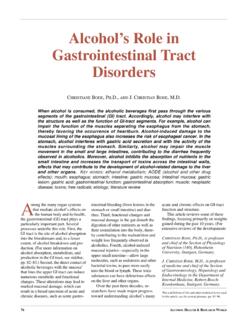Transcription of Biology of White Leg Shrimp, Penaeus vannamei: Review
1 World Journal of Fish and Marine Sciences 10 (2): 05-17, 2018 ISSN 2078-4589 IDOSI Publications, 2018 DOI: Author: Hailu Dugassa, Van Den Nestlaan 104, 2520 Broechem, Belgium. 5 Biology of White Leg Shrimp, Penaeus vannamei: ReviewHailu Dugassa and De Gyrse Gaetan12 Van Den Nestlaan 104, 2520 Broechem, Belgium1 Salisburylaan 133, 9820 Merelbeke, Belgium2 Abstract: Shrimp aquaculture plays a significant role in the world economy. According to the information ofthe Food and Agriculture Organization (FAO) of the United Nations, marine and brackish water shrimp cultureproductions have expanded from less than 10, 000 metric tonnes in 1970 more than 4, 000, 000 metric tonnes in2014.
2 The most of the aquaculture shrimp contribution has come from Penaeus vannamei which accounts 80%of the whole shrimp production. Although the cultivated shrimp production has rapidly increased during theseyears, the annual economic losses due to disease were estimated to be approximately 1 billion US dollar per yearsince the early 1990s. Viruses and bacteria mainly cause the diseases of the shrimp. Hence, most of thepublished reviews focused on the diseases and production aspects ofP. vannamei. However, the Biology ofthis species is neglected during the last two decades.
3 For better production and health management systemsof this species, it is paramount to have basic and solid knowledge of the Biology ofP. vannamei. However,there are limited reviews available on the Biology of P. vannamei. This is, thus, we are very motivated to reviewof the Biology of the shrimp for efficient health management and production of the shrimp. The life cycle of thisspecies is very complex and it usually takes around years to complete the whole life cycle of external morphology is well described and understood. We also highlighted the basicinternal morphology and physiology of this species.
4 There is limited information on the understanding ofnatural behaviour and feeding habits of this animal. Therefore, further studies are needed in future to have solidknowledge of internal morphology and physiology, natural behaviour and feeding habits ofP. vannamei inorder to improve the production and health management systems. Key words: Morphology Physiology Life Cycle Biology P. vannamei ShrimpINTRODUCTION production is from inland aquacultures [2]. TheAquatic food production has transformed fromwhich has reached million of tonnes with anprimarily based on fisheries to the culture of increasingestimated first sale value of billion Euros.
5 The othernumbers of farmed species. According to the statistics ofmost important species are the black tiger shrimpFAO [1], the total world aquaculture production was( Penaeus monodon). The production of this speciesfound around million tonnes in 2014. This figure hasreached million tonnes with a value of billionalmost increased by 11% compared to the production ofEuros [2].2012 which was around million tonnes[1]. The totalShrimp aquaculture plays a significant role in theworld aquaculture production of crustacean was economy.
6 According to the information of the Foodmillion tonnes in 2014 with an estimated total value ofand Agriculture Organization (FAO) of the billion Euros. This figure of crustacean productionNations, marine and brackish water shrimp cultureis almost increased by 7% compared to the productionproductions have expanded from less than 10, 000 metricfigures of 2012 ( million tonnes) with a value of in 1970 more than 4, 000, 000 metric tonnes in 2014billion Euros FAO [1]. Till now, more than 62 crustacean[1].
7 The most of the aquaculture shrimp contribution hasspecies have been cultured in aquaculture farms aroundcome fromPenaeus vannamei (P. vannamei) whichthe world. The mariculture contributes to of theaccounts 80% of the whole shrimp production. Althoughcrustacean production. The remaining of thethe cultivated shrimp production has rapidly increasedproduction from mariculture is dominated by P. vannameiWorld J. Fish & Marine Sci., 10 (2): 05-17, 20186during these years, the annual economic losses due todisease were estimated to be approximately 1 billion USdollar per year since the early 1990s [3].
8 Viruses andbacteria mainly cause the diseases of the shrimp. Theapplication of antibiotics in shrimp culture can solve theproblem related to the bacterial diseases. However,frequent and non-selective use of antibiotics can lead tothe development of bacterial resistance and new diseasedevelopment [4]. From the previous reviews and studies,Fig. 1: Schematic drawing of [7]we understand that most of the published reviewsfocused on the diseases and production aspects vannamei lives in tropical marine [3 - 6].
9 However, the Biology of this species isThe adults of this species live and spawn in the For better health management and productionHowever, the larvae and juveniles are usually found insystems of this shrimp species, it is paramount to haveinshore water areas such as coastal estuaries, lagoons orbasic and solid knowledge of the Biology of P. areas. The females of P. vannamei grow fasterHowever, there are limited reviews available on thecompared to the male of this species. The matured femalebiology of the shrimp. This is, thus, we are very motivatedofP.
10 Vannamei weighing 30-45 g can spawn 100, 000-250,to Review of the Biology of shrimp for efficient health000 eggs. The life cycle of the White leg shrimp is verymanagement and production of the shrimp. Therefore, thecomplex (Figure 2). The matured females of P. vannameiobjective of this paper is to Review of the Biology of whitespawn their eggs in the offshore waters [8]. Theleg Shrimp, P. occurs in the external environment. TheBiology of Penaeus vannamei: fertilization. After hatching process, the first larval stage,Taxonomy: The White leg shrimp, Penaeus vannamei [7]belongs to the phylum Arthropoda, which is defined byhaving joined appendages and an exoskeleton or cuticlewhich is periodically shed [8].

